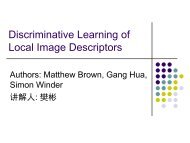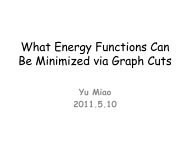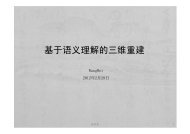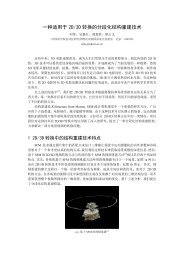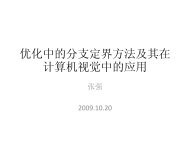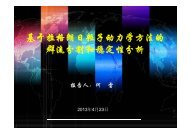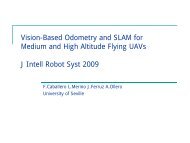Rotationally Invariant Descriptors using Intensity Order ... - IEEE Xplore
Rotationally Invariant Descriptors using Intensity Order ... - IEEE Xplore
Rotationally Invariant Descriptors using Intensity Order ... - IEEE Xplore
You also want an ePaper? Increase the reach of your titles
YUMPU automatically turns print PDFs into web optimized ePapers that Google loves.
This article has been accepted for publication in a future issue of this journal, but has not been fully edited. Content may change prior to final publication.<br />
<strong>IEEE</strong> TRANSACTION ON PATTERN ANALYSIS AND MACHINE INTELLIGENCE 5<br />
points are two types of popular interest points. Feature point detection is usually followed by an<br />
additional step of detecting affine invariant region around the interest point in order to deal with<br />
large viewpoint changes. Many methods in the literature have been proposed for this purpose.<br />
Widely used methods include the Harris-Affine/Hessian-Affine detector [9], Maximally Stable<br />
Extremal Regions (MSER) [19], intensity-based and edge-based detectors [20]. Please see [21]<br />
for a comprehensive study of these affine region detectors. Once interest regions have been<br />
extracted, they can be normalized to a canonical region which remains the same under affine<br />
transformations of the original local patches. Secondly, feature descriptors are constructed from<br />
these interest regions (affine normalized) in order to distinguish them from each other. The final<br />
step of point matching is to compute the distance between descriptors of two candidate points<br />
and to decide whether they are a match or not. Popular decision-making strategies are nearest<br />
neighbor (NN) and nearest neighbor distance ratio (NNDR) [22]. It has been shown in [22]<br />
that the rank of different descriptors is not influenced by matching strategies. This makes the<br />
comparison of local descriptors convenient as they do not need to be compared with all possible<br />
matching strategies.<br />
Local image descriptors have received a lot of attention in the computer vision community.<br />
Many local descriptors have been developed since the 1990s [6], [14], [15], [23]–[29]. Perhaps<br />
one of the most famous and popular descriptors is SIFT (Scale <strong>Invariant</strong> Feature Transform) [6].<br />
According to the comparative study of Mikolajczyk and Schmid [22], SIFT and its variant<br />
GLOH (Gradient Location and Orientation Histogram) outperform other local descriptors, in-<br />
cluding shape context [23], steerable filters [30], spin images [10], differential invariants [11],<br />
moment invariants [31]. Inspired by the high discriminative ability and robustness of SIFT,<br />
many researchers have developed various local descriptors following the way of SIFT. Ke and<br />
Sukthankar [24] applied PCA (Principal Component Analysis) [32] to gradient patch of keypoint<br />
and introduced the PCA-SIFT descriptor which was said to be more compact and distinctive<br />
than SIFT. Bay et al. [27] proposed an effective implementation of SIFT with the integral image<br />
technique, and they achieved 3 to 7-fold speed-ups. Tola et al. [16] developed a fast descriptor<br />
named DAISY for dense matching. Winder and Brown [33] proposed a framework to learn local<br />
descriptors with different combinations of local features and feature pooling schemes. The SIFT<br />
and many other descriptors can be incorporated into their framework. A DAISY-like descriptor<br />
was reported with the best performance among all configurations. Then, the best DAISY was<br />
November 26, 2011 DRAFT



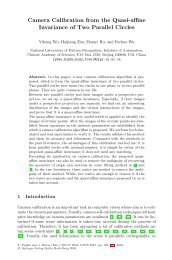
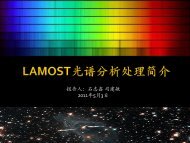
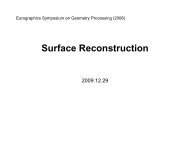
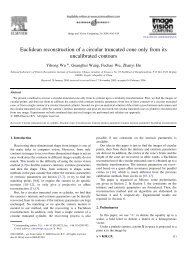
![Accurate, Dense, and Robust Multi-View Stereopsis (PMVS) [1,2,3]](https://img.yumpu.com/19388840/1/190x135/accurate-dense-and-robust-multi-view-stereopsis-pmvs-123.jpg?quality=85)
